Modernist muse: the art world significance of Mies van der Rohe’s collages

Drawn from MoMA's collections, a host of collages by Ludwig Mies van der Rohe are on display together for the first time at the Ludwig Forum in Aachen, Germany. The works provide a glimpse into van der Rohe’s design process, yet are also autonomous pieces of art. Displayed beside other artists of the 20th century, they place van der Rohe at the heart of the modernist movement.
Made between the years 1910 and 1965, van der Rohe used these large-scale collages to visualise space, presenting them for competitions, exhibitions and journals and using them to explore his ideas and theories for Neues Bauern or ‘New Building’.

Interior perspective of Project for Concert Hall, 1942, by Mies van der Rohe.
Combining illustration, sketches and photomontage, the collages are architecturally led, setting the principles of modernism with strong dimension-building lines and striking spatial concepts for interiors for built projects such as his Convention Hall in Chicago (1952–54) and also those that were never realised, such as Museum For a Small City (1941–43) and the Georg Schaefer Museum Project, Schweinfurt, Germany (1960–63).
Along with a precise grasp on composition from his architectural training, his artistic aesthetic took influence from the 20th century movements of dada, constructivism, and De Stijl (van der Rohe was both friends with artists and a collector himself).
The exhibition follows a chronological course, yet places his works in historical and artistic contexts, aligning them with contemporaries including Kurt Schwitters, Hannah Höch and László Moholy-Nagy, artists who were lifelong influences to his practice such as Paul Klee and Georges Braque, and practitioners who address his own architectural work, such as Thomas Ruff.
Curated by Andreas Beitin and Holger Otten in collaboration with Museum Georg Schäfer in Schweinfurt, Germany, the exhibition will travel to Schweinfurt next, from 26 February – 28 May 2017.
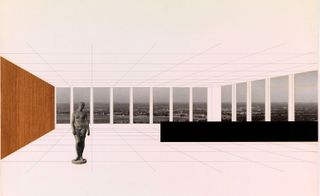
Interior perspective with view of site of the Georg Schaefer Museum Project, Schweinfurt, 1960–1963, by Mies van der Rohe.

Mies van der Rohe in his apartment, Chicago, 1964.
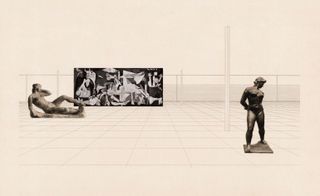
Interior perspective of Museum for a Small City, 1942–43, by Mies van der Rohe.
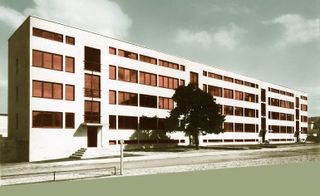
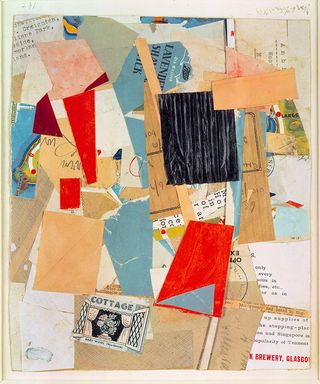
Ohne Titel (Cottage), by Kurt Schwitters.

Perspective of living room through the south glass wall of the unbuilt Resor House project (Jackson Hole, Wyoming), 1937–1941, by Mies van der Rohe.
INFORMATION
’Mies van der Rohe: The MoMA Collages’ is on view until 12 February 2017. For more information, visit the Ludwig Forum website
ADDRESS
Ludwig Forum
Jülicher Strasse 97–109
52070 Aachen
Wallpaper* Newsletter
Receive our daily digest of inspiration, escapism and design stories from around the world direct to your inbox
Harriet Thorpe is a writer, journalist and editor covering architecture, design and culture, with particular interest in sustainability, 20th-century architecture and community. After studying History of Art at the School of Oriental and African Studies (SOAS) and Journalism at City University in London, she developed her interest in architecture working at Wallpaper* magazine and today contributes to Wallpaper*, The World of Interiors and Icon magazine, amongst other titles. She is author of The Sustainable City (2022, Hoxton Mini Press), a book about sustainable architecture in London, and the Modern Cambridge Map (2023, Blue Crow Media), a map of 20th-century architecture in Cambridge, the city where she grew up.
-
 The 2024 Ivor Novello nominations for songwriting have been revealed
The 2024 Ivor Novello nominations for songwriting have been revealed77 British and Irish songwriters and composers make up this year's nominees, announced tonight at London's Groucho Club
By Charlotte Gunn Published
-
 Why Bollinger’s La Grande Année 2015 champagne is worth celebrating
Why Bollinger’s La Grande Année 2015 champagne is worth celebratingChampagne Bollinger unveils La Grande Année 2015 and La Grande Année Rosé 2015, two outstanding cuvées from an exceptional year in wine-making
By Melina Keays Published
-
 Lexus installation explores time at Milan Design Week 2024
Lexus installation explores time at Milan Design Week 2024Lexus brought designer Hideki Yoshimoto’s ‘Beyond the Horizon’ to Milan’s Art Point, part of its ongoing series of collaborations with Fuorisalone
By Nargess Shahmanesh Banks Published
-
 Reethaus is a performance space conceived as ‘a place for radical presence’ in Berlin
Reethaus is a performance space conceived as ‘a place for radical presence’ in BerlinReethaus, a newly opened cultural centre in Berlin, kick-starts a fresh era for the city’s growing creative neighbourhood of Flussbad
By Ellie Stathaki Published
-
 Duplex brings two houses together as a single, raw, theatrical home in Leipzig
Duplex brings two houses together as a single, raw, theatrical home in LeipzigDuplex by Atelier ST is a raw and textured family home born of the transformation of two smaller residential buildings in Leipzig, Germany
By Ellen Himelfarb Published
-
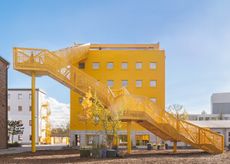 Berlin's Atelier Gardens gets bright yellow focal point within MVRDV masterplan
Berlin's Atelier Gardens gets bright yellow focal point within MVRDV masterplanThe bright yellow HAUS 1 becomes a key addition to Atelier Gardens in Berlin, part of an ever-evolving, sustainable masterplan by MVRDV
By Harriet Thorpe Published
-
 Bike-tyre maker Schwalbe’s HQ embraces sustainability through design
Bike-tyre maker Schwalbe’s HQ embraces sustainability through designThe new Schwalbe office building in Germany, featuring interiors designed by Archiproba Studios, champions contemporary sustainable architecture
By Ellie Stathaki Published
-
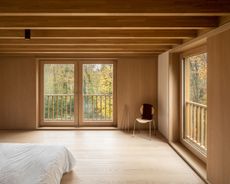 This Berlin house balances romance and strength in a scenic plot
This Berlin house balances romance and strength in a scenic plotA Berlin house transformed by O'Sullivan Skoufoglou is both romantic and protective
By Harriet Thorpe Published
-
 KHBT Studio crafts German suburban home overlooking a nature reserve
KHBT Studio crafts German suburban home overlooking a nature reserveHouse ZdM9 is a new German suburban home for a family, set on a spectacular site close to Frankfurt and the River Main
By Jonathan Bell Published
-
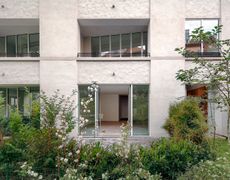 A ‘contemporary palazzo’ by David Chipperfield and Studio Mark Randel rises in Munich
A ‘contemporary palazzo’ by David Chipperfield and Studio Mark Randel rises in Munich‘Contemporary palazzo’ housing project in Munich is designed by David Chipperfield and Studio Mark Randel
By Ellen Himelfarb Published
-
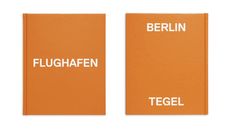 Last days of Berlin’s Tegel Airport celebrated in new photo book
Last days of Berlin’s Tegel Airport celebrated in new photo bookPhotographer Andreas Gehrke celebrates Tegel Airport and creates an intimate portrait of the place where the passengers have departed forever
By Jonathan Bell Published